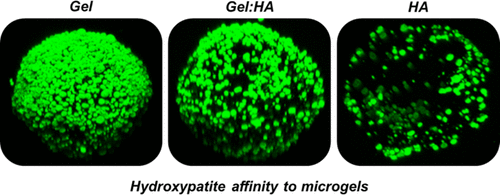当前位置:
X-MOL 学术
›
Biomacromolecules
›
论文详情
Our official English website, www.x-mol.net, welcomes your
feedback! (Note: you will need to create a separate account there.)
Interplay of Hydrogel Composition and Geometry on Human Mesenchymal Stem Cell Osteogenesis
Biomacromolecules ( IF 5.5 ) Pub Date : 2020-11-25 , DOI: 10.1021/acs.biomac.0c01408 Surakshya Shrestha 1 , Fanyi Li 1 , Vinh X Truong 1 , John S Forsythe 1 , Jessica E Frith 1
Biomacromolecules ( IF 5.5 ) Pub Date : 2020-11-25 , DOI: 10.1021/acs.biomac.0c01408 Surakshya Shrestha 1 , Fanyi Li 1 , Vinh X Truong 1 , John S Forsythe 1 , Jessica E Frith 1
Affiliation

|
Microgels are emerging as an outstanding platform for tissue regeneration because they overcome issues associated with conventional bulk/macroscopic hydrogels such as limited cell–cell contact and cell communication and low diffusion rates. Owing to the enhanced mass transfer and injectability via a minimally invasive procedure, these microgels are becoming a promising approach for bone regeneration applications. Nevertheless, there still remains a huge gap between the understanding of how the hydrogel matrix composition can influence cell response and overall tissue formation when switching from bulk formats to microgel format, which is often neglected or rarely studied. Here, we fabricated polyethylene glycol-based microgels and bulk hydrogels incorporating gelatin and hyaluronic acid (HA), either individually or together, and assessed the impact of both hydrogel composition and format upon the osteogenic differentiation of encapsulated human bone marrow-derived mesenchymal stem cells (hBMSCs). Osteogenesis was significantly greater in microgels than bulk hydrogels for both gelatin alone (Gel) and gelatin HA composite (Gel:HA) hydrogels, as determined by the expression of Runt-related transcription factor (Runx2) and alkaline phosphatase (ALP) genes and mineral deposition. Interestingly, Gel and Gel:HA hydrogels behaved differently between bulk and microgel format. In bulk format, overall osteogenic outcomes were better in Gel:HA hydrogels, but in microgel format, while the level of osteogenic gene expression was equivalent between both compositions, the degree of mineralization was reduced in Gel:HA microgels. Investigation into the affinity of hydroxyapatite for the different matrix compositions indicated that the decreased mineralization of Gel:HA microgels was likely due to a low affinity of hydroxyapatite to bind to HA and support mineral deposition, which has a greater impact on microgels than bulk hydrogels. Together, these findings suggest that both hydrogel composition and format can determine the success of tissue formation and that there is a complex interplay of these two factors on both cell behavior and matrix deposition. This has important implications for tissue engineering, showing that hydrogel composition and geometry must be evaluated together when optimizing conditions for cell differentiation and tissue formation.
中文翻译:

水凝胶组成和几何形状对人间充质干细胞成骨的相互作用
由于微凝胶克服了与传统的块状/宏观水凝胶相关的问题,例如有限的细胞间接触和细胞通讯以及低扩散速率,微凝胶正成为组织再生的杰出平台。由于通过微创程序增强了质量传递和可注射性,这些微凝胶正成为骨再生应用的有前途的方法。然而,在从批量形式转换为微凝胶形式时,对水凝胶基质组成如何影响细胞反应和整体组织形成的理解之间仍然存在巨大差距,而这通常被忽略或很少研究。在这里,我们单独或一起制造了结合明胶和透明质酸(HA)的聚乙二醇基微凝胶和本体水凝胶,并评估了水凝胶组成和形式对封装人骨髓间充质干细胞(hBMSCs)成骨分化的影响。由明胶相关转录因子(Runx2)和碱性磷酸酶(ALP)基因和矿物质的表达确定,对于明胶单独(Gel)和明胶HA复合材料(Gel:HA)水凝胶,微凝胶中的成骨作用明显大于本体水凝胶。沉积。有趣的是,凝胶和凝胶:HA水凝胶在本体和微凝胶形式之间表现不同。在散装形式中,Gel:HA水凝胶的总体成骨效果更好,但在微凝胶形式中,虽然两种组合物的成骨基因表达水平相同,但在Gel:HA微凝胶中矿化度降低了。对羟基磷灰石对不同基质组成的亲和力的研究表明,Gel:HA微凝胶的矿化减少可能是由于羟基磷灰石与HA结合并支持矿物质沉积的亲和力低,这对微凝胶的影响要大于本体水凝胶。总之,这些发现表明水凝胶的组成和形式都可以决定组织形成的成功,并且这两个因素对细胞行为和基质沉积都有复杂的相互作用。这对组织工程具有重要意义,表明在优化细胞分化和组织形成的条件时必须同时评估水凝胶的组成和几何形状。HA微凝胶可能是由于羟基磷灰石与HA结合并支持矿物质沉积的亲和力低,与微细水凝胶相比,它对微凝胶的影响更大。总之,这些发现表明水凝胶的组成和形式都可以决定组织形成的成功,并且这两个因素对细胞行为和基质沉积都有复杂的相互作用。这对组织工程具有重要意义,表明在优化细胞分化和组织形成的条件时必须同时评估水凝胶的组成和几何形状。HA微凝胶可能是由于羟基磷灰石与HA结合并支持矿物质沉积的亲和力低,与微细水凝胶相比,它对微凝胶的影响更大。总之,这些发现表明水凝胶的组成和形式都可以决定组织形成的成功,并且这两个因素对细胞行为和基质沉积都有复杂的相互作用。这对组织工程具有重要意义,表明在优化细胞分化和组织形成的条件时必须同时评估水凝胶的组成和几何形状。这些发现表明,水凝胶的组成和形式都可以决定组织形成的成功,并且这两个因素对细胞行为和基质沉积都有复杂的相互作用。这对组织工程具有重要意义,表明在优化细胞分化和组织形成的条件时必须同时评估水凝胶的组成和几何形状。这些发现表明,水凝胶的组成和形式都可以决定组织形成的成功,并且这两个因素对细胞行为和基质沉积都有复杂的相互作用。这对组织工程具有重要意义,表明在优化细胞分化和组织形成的条件时必须同时评估水凝胶的组成和几何形状。
更新日期:2020-12-14
中文翻译:

水凝胶组成和几何形状对人间充质干细胞成骨的相互作用
由于微凝胶克服了与传统的块状/宏观水凝胶相关的问题,例如有限的细胞间接触和细胞通讯以及低扩散速率,微凝胶正成为组织再生的杰出平台。由于通过微创程序增强了质量传递和可注射性,这些微凝胶正成为骨再生应用的有前途的方法。然而,在从批量形式转换为微凝胶形式时,对水凝胶基质组成如何影响细胞反应和整体组织形成的理解之间仍然存在巨大差距,而这通常被忽略或很少研究。在这里,我们单独或一起制造了结合明胶和透明质酸(HA)的聚乙二醇基微凝胶和本体水凝胶,并评估了水凝胶组成和形式对封装人骨髓间充质干细胞(hBMSCs)成骨分化的影响。由明胶相关转录因子(Runx2)和碱性磷酸酶(ALP)基因和矿物质的表达确定,对于明胶单独(Gel)和明胶HA复合材料(Gel:HA)水凝胶,微凝胶中的成骨作用明显大于本体水凝胶。沉积。有趣的是,凝胶和凝胶:HA水凝胶在本体和微凝胶形式之间表现不同。在散装形式中,Gel:HA水凝胶的总体成骨效果更好,但在微凝胶形式中,虽然两种组合物的成骨基因表达水平相同,但在Gel:HA微凝胶中矿化度降低了。对羟基磷灰石对不同基质组成的亲和力的研究表明,Gel:HA微凝胶的矿化减少可能是由于羟基磷灰石与HA结合并支持矿物质沉积的亲和力低,这对微凝胶的影响要大于本体水凝胶。总之,这些发现表明水凝胶的组成和形式都可以决定组织形成的成功,并且这两个因素对细胞行为和基质沉积都有复杂的相互作用。这对组织工程具有重要意义,表明在优化细胞分化和组织形成的条件时必须同时评估水凝胶的组成和几何形状。HA微凝胶可能是由于羟基磷灰石与HA结合并支持矿物质沉积的亲和力低,与微细水凝胶相比,它对微凝胶的影响更大。总之,这些发现表明水凝胶的组成和形式都可以决定组织形成的成功,并且这两个因素对细胞行为和基质沉积都有复杂的相互作用。这对组织工程具有重要意义,表明在优化细胞分化和组织形成的条件时必须同时评估水凝胶的组成和几何形状。HA微凝胶可能是由于羟基磷灰石与HA结合并支持矿物质沉积的亲和力低,与微细水凝胶相比,它对微凝胶的影响更大。总之,这些发现表明水凝胶的组成和形式都可以决定组织形成的成功,并且这两个因素对细胞行为和基质沉积都有复杂的相互作用。这对组织工程具有重要意义,表明在优化细胞分化和组织形成的条件时必须同时评估水凝胶的组成和几何形状。这些发现表明,水凝胶的组成和形式都可以决定组织形成的成功,并且这两个因素对细胞行为和基质沉积都有复杂的相互作用。这对组织工程具有重要意义,表明在优化细胞分化和组织形成的条件时必须同时评估水凝胶的组成和几何形状。这些发现表明,水凝胶的组成和形式都可以决定组织形成的成功,并且这两个因素对细胞行为和基质沉积都有复杂的相互作用。这对组织工程具有重要意义,表明在优化细胞分化和组织形成的条件时必须同时评估水凝胶的组成和几何形状。











































 京公网安备 11010802027423号
京公网安备 11010802027423号